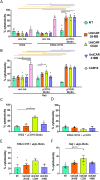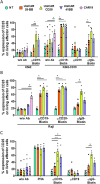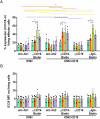High specificity of engineered T cells with third generation CAR (CD28-4-1BB-CD3-ζ) based on biotin-bound monomeric streptavidin for potential tumor immunotherapy
- PMID: 39364400
- PMCID: PMC11446752
- DOI: 10.3389/fimmu.2024.1448752
High specificity of engineered T cells with third generation CAR (CD28-4-1BB-CD3-ζ) based on biotin-bound monomeric streptavidin for potential tumor immunotherapy
Abstract
Introduction: Immunotherapy has revolutionized cancer treatment, and Chimeric Antigen Receptor T cell therapy (CAR-T) is a groundbreaking approach. Traditional second-generation CAR-T therapies have achieved remarkable success in hematological malignancies, but there is still room for improvement, particularly in developing new targeting strategies. To address this limitation, engineering T cells with multi-target universal CARs (UniCARs) based on monomeric streptavidin has emerged as a versatile approach in the field of anti-tumor immunotherapy. However, no studies have been conducted on the importance of the intracellular signaling domains of such CARs and their impact on efficiency and specificity.
Method: Here, we developed second-generation and third-generation UniCARs based on an extracellular domain comprising an affinity-enhanced monomeric streptavidin, in addition to CD28 and 4-1BB co-stimulatory intracellular domains. These UniCAR structures rely on a biotinylated intermediary, such as an antibody, for recognizing target antigens. In co-culture assays, we performed a functional comparison between the third-generation UniCAR construct and two second-generation UniCAR variants, each incorporating either the CD28 or 4-1BB as co-stimulatory domain.
Results: We observed that components in culture media could inhibit the binding of biotinylated antibodies to monomeric streptavidin-CARs, potentially compromising their efficacy. Furthermore, third-generation UniCAR-T cells showed robust cytolytic activity against cancer cell lines upon exposure to specific biotinylated antibodies like anti-CD19 and anti-CD20, underscoring their capability for multi-targeting. Importantly, when assessing engineered UniCAR-T cell activation upon encountering their target cells, third-generation UniCAR-T cells exhibited significantly enhanced specificity compared to second-generation CAR-T cells.
Discussion: First, optimizing culture conditions would be essential before deploying UniCAR-T cells clinically. Moreover, we propose that third-generation UniCAR-T cells are excellent candidates for preclinical research due to their high specificity and multi-target anti-tumor cytotoxicity.
Keywords: Chimeric Antigen Receptor; Treg; engineered cells; immunosuppression; streptavidin-based CAR.
Copyright © 2024 Gallego-Valle, Pérez-Fernández, Rosales-Magallares, Gil-Manso, Castellá, Gonzalez-Navarro, Correa-Rocha, Juan and Pion.
Conflict of interest statement
The authors declare that the research was conducted in the absence of any commercial or financial relationships that could be construed as a potential conflict of interest. The author(s) declared that they were an editorial board member of Frontiers, at the time of submission. This had no impact on the peer review process and the final decision.
Figures







Similar articles
-
T cells engrafted with a UniCAR 28/z outperform UniCAR BB/z-transduced T cells in the face of regulatory T cell-mediated immunosuppression.Oncoimmunology. 2019 Jun 7;8(9):e1621676. doi: 10.1080/2162402X.2019.1621676. eCollection 2019. Oncoimmunology. 2019. PMID: 31428518 Free PMC article.
-
Universal CAR T cells targeted to HER2 with a biotin-trastuzumab soluble linker penetrate spheroids and large tumor xenografts that are inherently resistant to trastuzumab mediated ADCC.Front Immunol. 2024 Mar 18;15:1365172. doi: 10.3389/fimmu.2024.1365172. eCollection 2024. Front Immunol. 2024. PMID: 38562932 Free PMC article.
-
The impact of CD3ζ ITAM multiplicity and sequence on CAR T-cell survival and function.Front Immunol. 2025 Jan 16;15:1509980. doi: 10.3389/fimmu.2024.1509980. eCollection 2024. Front Immunol. 2025. PMID: 39885989 Free PMC article.
-
Advances in CAR optimization strategies based on CD28.Front Immunol. 2025 Mar 13;16:1548772. doi: 10.3389/fimmu.2025.1548772. eCollection 2025. Front Immunol. 2025. PMID: 40181986 Free PMC article. Review.
-
Engineering Cytoplasmic Signaling of CD28ζ CARs for Improved Therapeutic Functions.Front Immunol. 2020 Jun 19;11:1046. doi: 10.3389/fimmu.2020.01046. eCollection 2020. Front Immunol. 2020. PMID: 32636832 Free PMC article. Review.
References
MeSH terms
Substances
LinkOut - more resources
Full Text Sources
Research Materials

